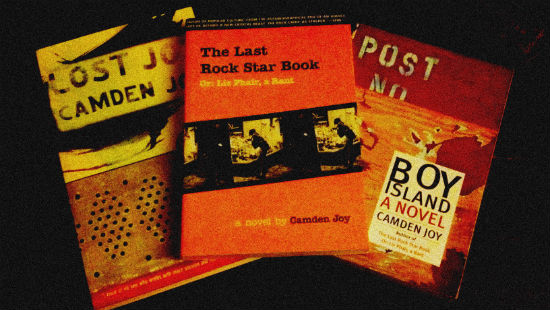
The three books by Camden Joy that I own were released by three different publishers, but looking at all of them together, a shared design aesthetic emerges. Is it coincidence that there’s a sense of collage from all of them, of disparate elements coming together? Camden Joy is himself a pseudonym used by Tom Adelman — though it would seem to make sense that this identity, more than most pseudonyms, would develop a life of its own.
Alternately? I’ve had a Camden Joy poster on my wall for a decade now. A friend of mine ran TNI Books, the small press that released Lost Joy, a collection of Joy’s shorter pieces that encompassed everything from his great Fifty Posters About Souled American to biographical information revealed through notes on songs to manifestoes and surreal fiction. I heard Joy read at Spoonbill and Sugartown when it came out; he played a bit of Souled American’s “She Broke My Heart,” and I went home and ordered the band’s discography later that night.
A few years ago, I revisited Joy’s body of work — specifically, his novel Boy Island — for an article I was working on about pop music in works of fiction. Though this might be misleading, given that the group at the center of Boy Island is a band fronted by David Lowery. Joy’s The Last Rock Star Book centers itself around Liz Phair — though it’s as much about obsession with pop music in general as it is about Phair specifically. And both Boy Island and The Last Rock Star Book don’t shy away from some of the more unpleasant aspects about alt-rock culture: rituals, emotional awkwardness, obsession. What Joy evokes — wonderfully, I’d say — is the way that music can, for some of us, seep into every aspect of our being. The song we love isn’t just the song we love: it’s the soundtrack playing in our mind for crucial moments in our lives. The way we might relate to a rock star can lead us towards a deeper understanding of their music — or it might lead us to assume a personal bond where none exists. This isn’t always a liberating thing, in Joy’s writing. It’s problematic and tangled up in itself, which only makes it feel truer to life.
It’s probably worth mentioning here that Joy, along with Paul Nelson, is one of the models for Perkus Tooth in Jonathan Lethem’s Chronic City. (I’d say Tooth is more Nelson than Joy, but elements of each are clearly out in the open.) And if that doesn’t catch your eye, it’s also worth mentioning that an upcoming panel at Housing Works, with participants including Trinie Dalton, Adam Wilson, and Justin Taylor, will discuss Joy’s work. And if it prompts more readers for his surreal, heartfelt work, so much the better.
Follow Vol. 1 Brooklyn on Twitter, Facebook, Google +, our Tumblr, and sign up for our mailing list.
